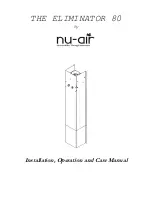
NOTE
:
1. Do not remove the styrofoam packing from the float on the unit. The float on the unit will no longer be
able to detect the water level correctly without the styrofoam packing, and water may leak from the water
tank. This can cause electrical shock and/or short circuits. (see Fig. 1)
2. If the drainage tank is dirty, wash it with cold or lukewarm water. Do not use detergent, scouring pads,
chemically treated dust cloths, gasoline, benzene, thinner, or other solvents, as these can scratch and
damage the tank and cause water leakage.
3. When replacing the drainage tank, press the tank firmly into place with both hands. (see Fig. 2) If the
tank is not positioned properly, the “TANK FULL” sensor will be activated, and the dehumidifier will not
operate. Check to make sure the guards are firmly attached to the tank. If they are not, the drainage tank
will be more difficult to remove. (see Fig. 3)
4. If the drainage tank is removed while the unit is in operation, or immediately after operation has
stopped, water that is still in the cooling unit may drip out on the base plate. Wait at least 30 minutes
before removing the drainage tank. (If water has dripped, wipe it up.)
9
Fig. 1 Fig.2 Fig.3
Continuous Water Drainage
The unit features a continuous drainage port. Using a commercial hose (with an inner diameter of 15
mm), the water in the drainage tank can be continuously drained out of the continuous port on the unit.
NOTE:
When setting up the equipment for continuous drainage, always stop operation first and unplug
the power supply plug.
1. Remove the drainage tank and open the continuous drainage port. Use snipers or a similar tool to cut
away the continuous drainage cap in the side of the main unit. (see Fig. 4)
2. Push the hose into the continuous drainage port. Pass the hose through the continuous drainage port,
and press it firmly onto the drainage port in the main unit. The average height of drain hose should
always be lower than the drainage port. Drain piping should always be kept clean and clear of blockage
so the condensed water can be drained out successfully. (see Fig. 5)
3. Replace the drainage tank to its original position. Check the hose periodically to make sure it is still
connected and has not been obstructed. (see Fig. 6)
4. The drain hose must always maintain a downhill grade to make sure that collected water can be
drained out with the force of gravity.































